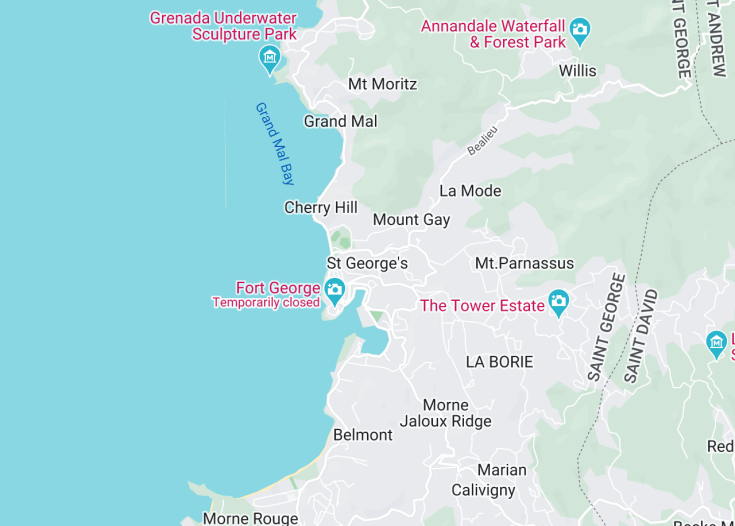Nestled on the southwestern tip of the island of Grenada, St. George’s serves as not only the capital city but also a picturesque hub of culture, history, and vibrant island life. This port city, with its horseshoe-shaped harbor backed by a hillside of colorful homes, offers an enchanting blend of colonial architecture, lively markets, and lush natural surroundings. Renowned for its well-preserved forts like Fort George and its bustling spice market, St. George’s attracts travelers seeking a unique Caribbean experience immersed in genuine hospitality and rich traditions.
For an unforgettable experience, ensure to explore the historic Fort George, which offers panoramic views of the harbor and beyond.
Visit the market early in the morning to enjoy the freshest spices and interact with local vendors for an authentic Grenadian experience.
Top things to do & see in St. George’s
Select the following sights and activities to discover best tickets and tours available in St. George’s.
St. George’s: The Vibrant Heart of Grenada
| Country | Grenada |
| Time in St. George’s | GMT-4 |
| Language spoken | English |
| Population | 37,057 (Based on the latest census data) |
| Currency | Eastern Caribbean Dollar (XCD $) |
| Airports | Maurice Bishop International Airport (5 mi / 8 km). |
St. George’s, the capital city of Grenada, is nestled on the island’s southwest coast and serves as the principal port and commercial center of the region. Its significant history is etched into the vibrant architecture and bustling streets where you can still find colonial buildings alongside modern establishments. St. George’s is not only the administrative center of Grenada but also a cultural beacon with its array of festivals, music, and culinary influences reflecting a blend of African, French, and British heritage.
The town’s topography is uniquely dramatic, characterized by a horseshoe-shaped harbor backed by a hillside of an old volcano crater, making it one of the most picturesque capitals in the Caribbean. A stroll along the Carenage, St. George’s lively waterfront, provides scenic views and reveals many historic sites such as Fort George, which overlooks the town from a promontory. The fort provides a panoramic view of the harbor and beyond, which is especially captivating at sunset.
Every aspect of St. George’s—from its cobblestone streets and vibrant market square to the colorful rooftops and church steeples—tells a story of traditions, resilience, and growth. The market square, once a center for trading slaves, now buzzes with vendors selling spices, fruits, and local crafts that embody Grenadian culture. A short distance from the bustling market is the National Museum of Grenada, where artifacts and exhibitions speak volumes about the island’s history and the evolution of its people and politics.
St. George’s is also renowned for its culinary scene which is predominantly Creole, blending spices and techniques from various traditions. The town boasts numerous eateries where locals and visitors can savor dishes like oil down, the national dish made from breadfruit, coconut milk, and salted meat among other ingredients.
Culturally, St. George’s is pulsating with rhythms of calypso and reggae music, especially vibrant during the annual Carnival where the streets are transformed with parades, music, and dancing. This festival, held in August, is a kaleidoscope of color and sound, drawing participants from all over the world.
In summary, St. George’s is not just the administrative heart of Grenada but also a focal point of culture, history, and natural beauty, making it an essential destination for anyone visiting the Caribbean.
Where is St. George’s?
Located on the island’s southwest coast, St. George’s is the bustling capital of Grenada, known for its horseshoe-shaped harbor and vibrant cultural scene.
Distances:
| Route | Distance by car | Time by car |
|---|---|---|
| Gouyave to St. George’s | 10 mi (16 km) | 25 min |
| Grande Anse to St. George’s | 5 mi (8 km) | 10 min |
| St. David’s to St. George’s | 12 mi (19 km) | 30 min |
What is St. George’s famous for?
St. George’s is famous for its deep-rooted history, evident in its preserved colonial architecture and bustling markets, and for its dynamic cultural scene highlighted by its spirited annual Carnival celebration.
History
Pre-Colonial Period – Before 1498
Before the arrival of Europeans, Grenada was inhabited by indigenous peoples, including the Arawaks who were later displaced by the Caribs. These early inhabitants called the island ‘Camahogne’ and lived primarily by fishing and basic agriculture, using the rich fertile soil to grow crops that sustained their communities.
Colonial Era – 1498-1974
St. George’s history as a recognized settlement began when Christopher Columbus sighted Grenada in 1498 during his third voyage to the new world. However, it was not until 1650 when French settlers from Martinique purchased the island from the Caribs, that St. George’s was officially established. Initially named Fort Royal, it was later renamed St. George’s after the famous British Admiral George Monck in 1763 when the British took control as part of the Treaty of Paris. The town then developed rapidly as a major port for the spice trade, particularly in nutmeg and mace, earning Grenada the title ‘Spice Isle’.
Modern Period – 1974 to Present
Grenada achieved independence from Britain on February 7, 1974. St. George’s became not only the capital city but also the cultural, economic, and political hub of the island. In recent decades, it has focused on tourism and services, transforming its waterfront and historical sites into attractions. Despite facing challenges such as the devastation wrought by Hurricane Ivan in 2004, St. George’s has shown remarkable resilience, rebuilding and modernizing while maintaining its rich historical charm and vibrant Caribbean spirit.
Visit St. George’s
What to see and do in St. George’s, Grenada.
St. George’s offers a blend of natural beauty and historical sites that beckon to be explored. Key attractions include:
- The Carenage, a picturesque waterfront promenade, perfect for walks and dining with views of colorful fishing boats and yachts.
- Fort George, offering panoramic views of the town and harbor, rich with historical significance dating back to 1705.
- The Grenada National Museum, housing artifacts and exhibits that tell the story of Grenada’s history from pre-colonial times to modern day.
- Market Square, a vibrant marketplace where vendors sell spices, fruits, and local crafts, providing a taste of local life.
- St. George’s Cathedral, a beautiful example of Gothic architecture with impressive stained glass windows and peaceful ambiance.
Festivals of St. George’s
St. George’s is lively with events throughout the year, highlighted by the colorful Grenada Carnival (commonly known as Spicemas). This explosive festival of colors, music, and dance takes place in August and is a vibrant expression of local culture and history. Additionally, the Chocolate Fest in May celebrates Grenada’s organic and sustainably produced chocolate, attracting connoisseurs from around the globe.
Best time to visit St. George’s
The best time to visit St. George’s is during the dry season, from January to May, when the weather is most favorable for outdoor activities and sightseeing. The city’s beauty peaks between these months, coinciding with numerous local and cultural festivities.
Is St. George’s worth visiting?
St. George’s is undoubtedly worth visiting for its rich blend of history, culture, and natural beauty. This charming capital offers a unique blend of old and new, from historic forts and buildings to lively markets and stunning beachfronts. Whether you’re a history enthusiast, nature lover, or simply seeking a peaceful Caribbean escape, St. George’s provides a fulfilling and memorable experience.










